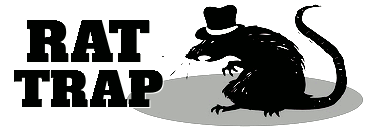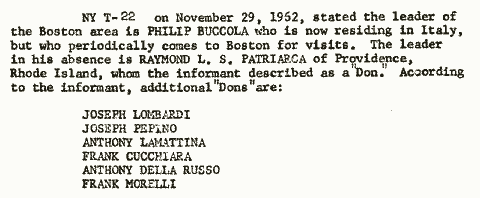All my life I'd been loyal to the mob. It never crossed my mind to be an informer, a pigeon for the cops. I'd rather die.
- Vincent Teresa [1]
Vincent "Fat Vinnie" Teresa achieved notoriety in the 1970s after he became a cooperating witness against the mob. The former New England Crime Family mobster testified at more than a dozen mob trials and made a televised appearance before a United States Senate committee investigating organized crime. Teresa's tales of mob life and his distinctive appearance - a large head, massive frame and gravely voice - made him the most infamous mobster in America for a time.
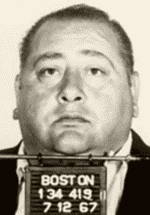
Teresa
In 1973, Teresa released his bestselling memoir. He wrote that he grew up in Boston, Massachusetts, the grandson of a Mafia "don." He worked any scam or swindle for money. He operated nightclubs, fixed horse races, robbed banks, stole jewelry and led gambling junkets around the world. Teresa claimed he made tens of millions for himself and his mob partners.
In 1969, Teresa was convicted of transporting and selling stolen securities (a stock or bond certificate). He would act as a middleman for the thief who stole the security and the buyer who would try to cash it. He was appealing a twenty-year prison sentence when he was arrested again for a similar offense. His criminal associates took the opportunity to threaten his family and steal millions of dollars from him that he had secretly tied up in mob businesses. It left his family broke.
Teresa maintained that he had always lived by the mob's code of silence and never once considered talking to law enforcement before becoming a cooperating witness in 1970. To him, a rat was the worst thing in the world. According to Teresa's memoir and all his public statements over the years, it was only when his friends betrayed him that he decided to turn against them.
The truth was much different.
Vincent Teresa was 'BS 812'
According to the FBI, "[BS 812] who was first contacted in January 1963 (sic), was discontinued in August, 1968, after having furnished extensive information regarding organized crime and gambling matters in [Boston]. He was discontinued as an informant after it was learned that he was involved in major interstate transportation of stolen property violation. He was later arrested, convicted and sentenced to prison." [17]
Informant symbol code "BS 812" was never redacted in older FBI document releases (as opposed to the latest document releases in 2017/18 that leave all informant symbol codes unredacted). Symbol codes were redacted in the past to protect the informant's anonymity. An unredacted symbol code indicated the informant's cooperation was already public knowledge (although his identity may not have been obvious). [19]
In reality, Teresa was feeding confidential information to federal agents as early as 1962. [2] Eight years before he became a cooperating witness, Teresa was already the Federal Bureau of Investigation's principal "live" source (i.e., non-listening device) against the New England Crime Family. [3] Teresa was talking to federal agents a year before mob informer Joseph Valachi appeared on national television at the McClellan Hearings and first told the American public about La Cosa Nostra.
What motivated Teresa to secretly cooperate in 1962 (or earlier) remains classified. His memoir naturally makes no direct reference to it, and the available FBI documents don't provide any clues. Reading between the lines, however, the catalyst could have been his run-in with high-ranking Boston mobster Gennaro Angiulo. [4]
According to his memoir, Teresa earned Angiulo's ire after he beat up an associate of Gambino Crime Family caporegime Joseph Paterno. The New Jersey-based Paterno complained to Angiulo, and Teresa was called on the carpet. Angiulo had always hated Teresa and tried to use the assault as an excuse to kill him. For a time, Teresa lived in fear of his life.
Only the intervention of New England Crime Family boss Raymond Patriarca saved him. [5]
The altercation roughly overlaps the period when Teresa first cooperated in 1962. Although it's only speculation, Angiulo's threat on Teresa's life may have pushed Teresa into the arms of the FBI. [6] (The exact date of his cooperation isn't firmly established; it's only suggested by the available FBI documents.)
Money as leverage
Teresa was discontinued as a criminal informant after he was arrested in August 1968. He was likely a paid informant by then. His cooperation termination would have had a negative impact on his income at a time when he needed money to cover his legal fees. The FBI may have leveraged his desperation to pressure him into becoming a cooperating witness.
Things Teresa said
Parts of Vincent Teresa's official debriefing sessions with federal agents have been identified in declassified FBI documents. His true identity was hidden behind informant symbol code "BS 812." Teresa laid out the power structure in the New England Crime Family, identified the major players and the rackets they controlled. Not everything Teresa disclosed was necessarily accurate but, in the pre-Valachi era, it broke new ground and expanded the FBI's storehouse of Mafia Intel. Some of the same information from his debriefing sessions would later appear in his memoir.
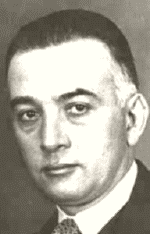
Buccola
According to Teresa, Philip Buccola was the overall ruler of the New England Crime Family. Buccola had once lived in Boston but retired to Sicily in 1954. He continued to visit Boston "periodically." [7]
Raymond Patriarca was the top "don" in Buccola's absence. Teresa said Patriarca controlled all the Italian rackets in New England except for parts of Western Massachusetts that fell under the control of Sam Cufari from New York. [8]
John "Williams" Guglielmo was formerly Buccola's "chief lieutenant." After Buccola moved back to Sicily, Williams was "pushed aside" by Boston mobster Gennaro Angiulo. Teresa said Angiulo had taken over as the "boss man" of Boston around 1962. [9] He added that Joseph Lombardi, a long-time power in the Italian underworld, could have replaced Williams but he didn't want the responsibility.
Other "dons" in New England were Joseph Lombardi, Joseph Pepino, Anthony Lamattina, Frank Cucchiara, Anthony Della Russo and Frank Morelli. According to Teresa, any individual of Italian extraction could be a member of the organization, but only a "Sicilian" could be a don.
Grandfather was a 'don'
In his memoir, Vincent Teresa states that his grandfather was a "don" back in Sicily and taught him about the Italian underworld. In federal debriefings produced ten years earlier, informant "BS 812" uses the same terminology to describe his own grandfather. [18]
Other "made" members included Anthony Sandrelli, Michael Rocco, Ralph Lamattina, and Orlando Napolitano in Maine. Teresa's friend and mentor Henry Tameleo was also a member.
According to Teresa, before an individual could be "made," he "would have to do something outstanding which the group recognized." If he had a good "temperament" and was "trustworthy," the group could vote him in as a member. [10]
Members swore an oath to put the organization above everything, including their own personal family. Membership was for life. In his memoir, Teresa alleged that he turned down the opportunity to become an inducted member of La Cosa Nostra. He wrote that he preferred to remain a "gypsy" and be free to operate where he wanted.
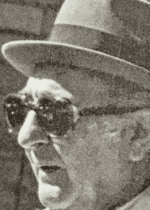
Ralph
Lamattina
In New England, the local crime organization was called "the Mafia, the Family and the Syndicate." [11] Teresa said "he was aware of this information because his grandfather was a Don in Italy in the town of Palermo, and he obtained the information through his family"
Mobsters in Boston met regularly above a "music shop located on Hanover street. [Teresa] described this as the meeting of the round table. He said at these meetings the Dons would assemble and discuss policy and other matters of importance." [12]
The group "controlled loan sharking, horse betting, numbers, narcotics, disposal of stolen merchandise and all other type of thievery of major importance in the greater Boston area."
The rackets were split into three areas of control. Gennaro Angiulo managed "numbers" (illegal gambling), Ralph Lamattina managed "narcotics" and an individual named Nicolo Giso managed "shylocking" (money lending). Teresa said that Lamattina and Giso were in serious trouble because they had recently "blown over $150,000 of the group's money." He speculated that Lamattina could be killed for messing up (he wasn't).
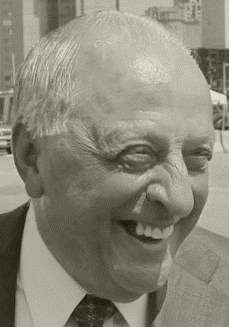
Limone
Teresa said Salvatore Cesario controlled narcotics for the New England mob before Lamattina. Cesario wasn't "made" and his reputation was considered "no good in the North End of Boston." Cesario had tried to get back into narcotics but Lamattina wouldn't let him. Teresa added that Cesario had many contacts in New Jersey through his business association with Newark-based Gambino Crime Family caporegime Joseph Paterno. Teresa wasn't clear if Paterno supplied drugs to Cesario or if it was the other way around.
Teresa said large bookmakers and numbers operators paid a small fee to the organization to be protected from the police. Small operators were exempt, but everyone else was forced to pay through threats of violence.
Teresa said Peter Limone was "an associate of Gennaro Angiulo and acts as a trouble shooter for him." But he didn't believe Limone had been "made."
Not only did Teresa provide historical information to help the FBI target mob big wigs, he fingered associates in recent crimes. For example, he told federal agents that Albert Giorgio, William Agisotellis and Maurice "Reno" Lerner had robbed the Boston Five Cent Savings Bank in 1963. Teresa said Giorgio had lost some of the loot gambling. [13] Giorgio and Agisotellis had also robbed the Suburban Trust Company. Teresa indicated in his memoir that he used to rob banks with them in the past. [14] It says something about Teresa that he would throw his old friends under the bus like that.
New Jersey connection
"BS 812" and Vincent Teresa both provided Intel about Gambino Crime Family caporegime Joseph Paterno. It would be unusual for a Boston-based FBI informant in the early 1960s to be familiar with a New Jersey-based mobster like Paterno. This connection helps to establish that Teresa was "BS 812". [20]
When Teresa strayed from his home turf in Boston, he became less reliable. For example, he described Vito Genovese as the top mobster in the country (which was arguably true). But then added that Thomas Lucchese looked after Genovese's interests while Genovese was in prison (untrue). And he called mid-level hoodlum Frankie Carbo, "the number 3 [mobster] in the country." [15]
And he had only the vaguest idea about who were the main players in other mob cities. For example, Teresa said the underworld in Detroit was controlled by an unidentified individual he called "Dominic Tringale." And he incorrectly stated that Frankie Carbo controlled Baltimore. [16]
Despite some hiccups in his statements, Teresa was far more important to the FBI's early efforts to combat organized crime than was ever previously imagined. Years before it was publicly acknowledged, he was secretly sharing confidential information about the New England Crime Family and helping the FBI target its main players. The new cooperation timeline calls into question Teresa's stated reasons for becoming a cooperating witness in the first place.
Notes
1 Teresa, Vincent, with Thomas C. Renner, My Life in the Mafia, Garden City, New York: Doubleday & Company, Inc., 1973, p. 11.
2 FBI, Crime Conditions in Miami Beach, Florida, Miami Office, March 19, 1963, NARA Record No. 124-90031-10015. Teresa (BS 812) was informant T-59. He was talking as early as September 1962.
3 It appears the FBI didn't develop a fully inducted member-informant in the crime family until later.
4 Teresa, My Life in the Mafia, p. 106.
5 The altercation with Joseph Paterno tends to show that Teresa and "BS 812" were the same individual. Like Teresa, "BS 812" also disclosed information about Paterno. Not many Boston mobsters would have information about a New Jersey mobster.
6 FBI, Crime Conditions in Miami Beach, Florida, Miami Office, March 19, 1963, NARA Record No. 124-90031-10015. Teresa was informant T-59. One of the first things Teresa disclosed to federal agents was Intel about Gennaro Angiulo.
7 FBI, La Causa Nostra, New York Office, Jan. 31, 1963, NARA Record No. 124-10211-10300. Informant "T-22" is Teresa; According to most other later sources, Buccola formally stepped down as boss in 1954 and was replaced by Raymond Patriarca. Buccola became an elder statesman who was consulted on occasion.
8 FBI, La Cosa Nostra, Boston Office, Sept. 11, 1967, NARA Record No. 124-10293-10336. Cufari was a member of the Genovese Crime Family.
9 FBI, Crime Conditions in Miami Beach, Florida, Miami Office, March 19, 1963, NARA Record No. 124-90031-10015.
10 FBI, The Criminal "Commission", Boston Office, Dec. 21, 1962, NARA Record No. 124-10217-10097.
11 FBI, The Criminal "Commission", Boston Office, Dec. 21, 1962, NARA Record No. 124-10217-10097.
12 Teresa, Vincent, with Thomas C. Renner, Vinnie Teresa's Mafia, Garden City, New York: Doubleday & Company, Inc., 1975, p. 179. Teresa refers to the same music shop and "round table" in his second book.
13 FBI, Suburban National Bank, Boston Office, Dec. 6, 1963, NARA Record No. 124-10209-10474. Also known as George (Billy A) Agistotelis, he was later murdered by Lerner. Teresa told federal agents not to approach Lerner about the robberies because it would lead back to him.
14 Teresa, My Life in the Mafia, p. 68.
15 FBI, The Criminal "Commission", Boston Office, Dec. 21, 1962, NARA Record No. 124-10217-10097.
16 FBI, The Criminal "Commission", Boston Office, Dec. 21, 1962, NARA Record No. 124-10217-10097.
17 FBI, U.S. House Select Committee On Intelligence Activities (HSC), FBI Director, Dec. 12, 1975, NARA Records No. 124-10274-10041. Teresa was actually cooperating as early as September 1962. "BS" refers to the FBI's Boston office.
18 FBI, The Criminal "Commission", Boston Office, Dec. 21, 1962, NARA Record No. 124-10217-10097; Teresa, My Life in the Mafia, p. 2.
19 FBI, Robbery at Veterans Administration Hospital, Boston Office, Sept. 14, 1966, NARA Record No. 124-10209-10469. According to Teresa's memoir, John Kehoe was the same FBI agent that persuaded him to become a cooperating witness in 1970.
20 Teresa, My Life in the Mafia, p. 106.
